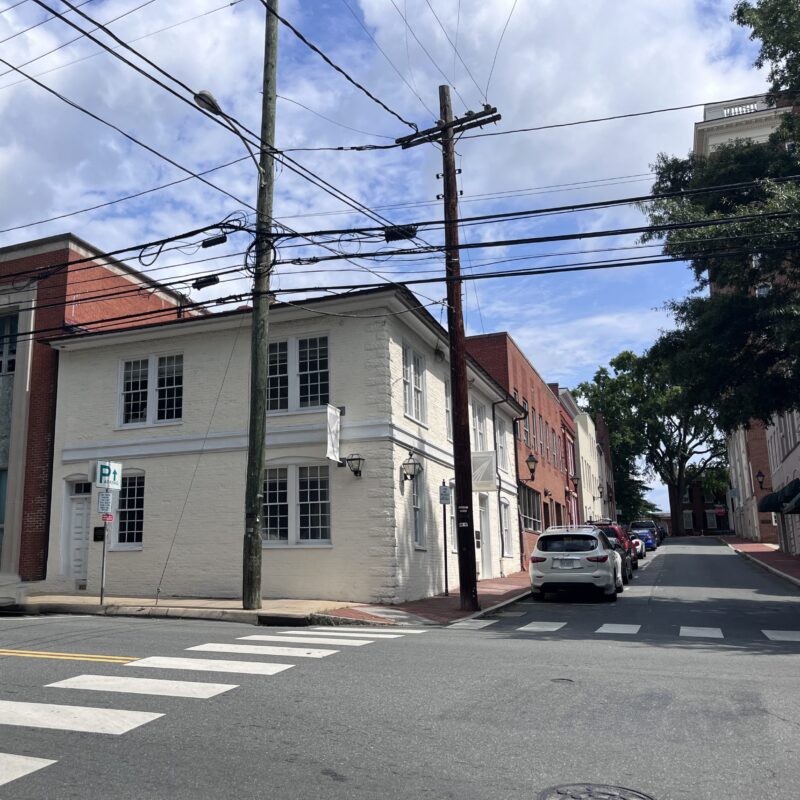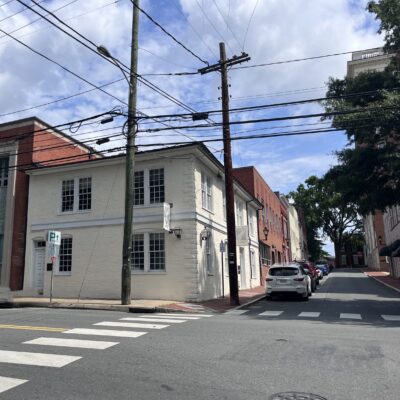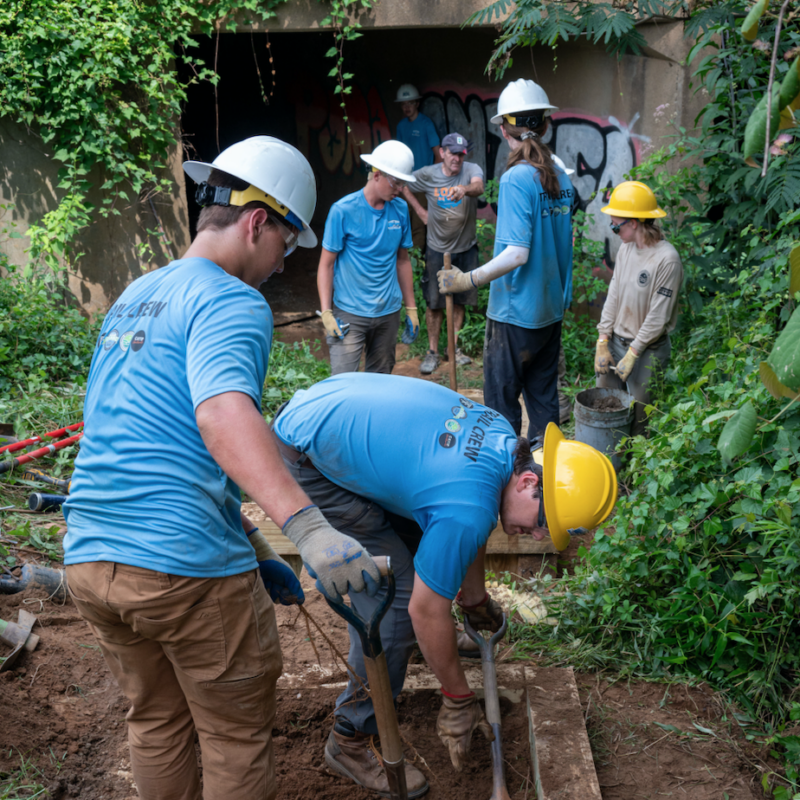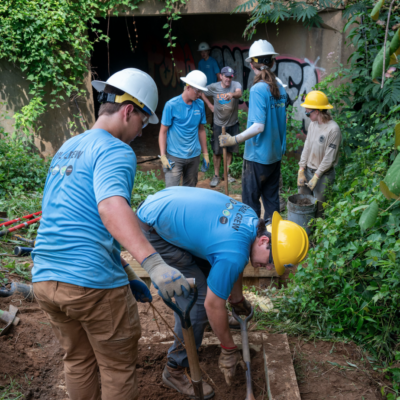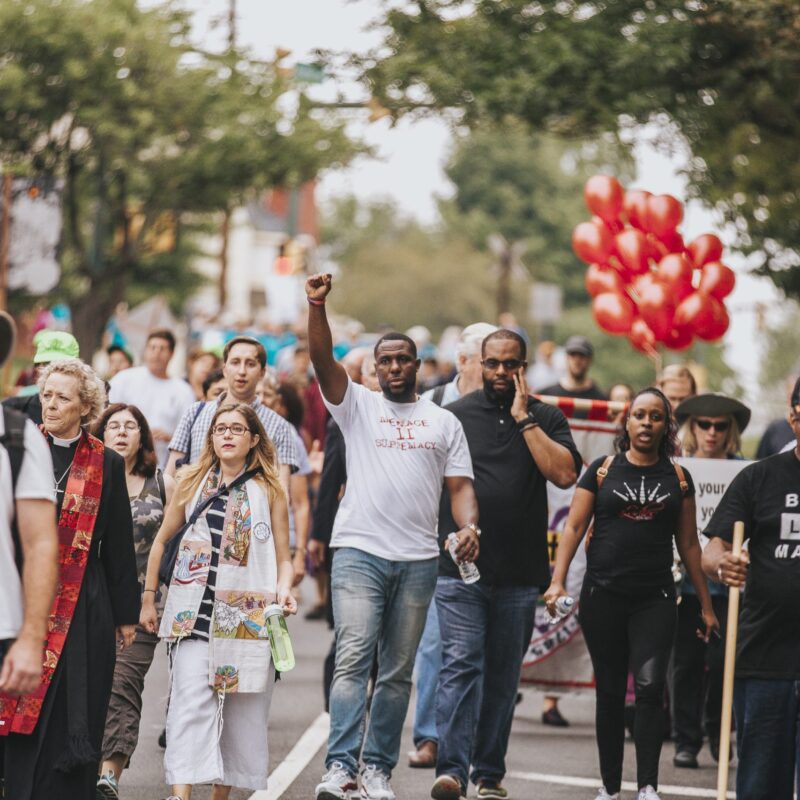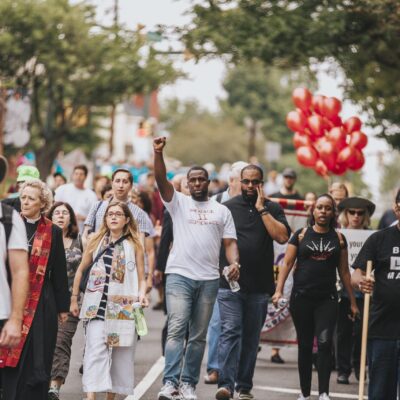Greg Kelly takes his time making coffee in a silver pot in his little Belmont house. He’s talking about what it means to be an artist, something that had been on his mind in the early part of this decade, after he’d landed in Batesville with a newly minted education in studio art. “I didn’t want to be this isolated, misunderstood misanthrope that’s drunk in his studio, producing masterworks that will be discovered later on after I die,” he says.
Eight or nine years later, it seems, Kelly could hardly be less isolated. Or less misanthropic. He’s the affable, beloved director of The Bridge/Progressive Arts Initiative—that squat, chocolate-brown place next to Spudnuts, with the painted smoke swirling around its walls. The Bridge just turned five in September, and Kelly (oh, let’s call him Greg; everybody else does) is, as his co-founder Zack Worrell calls him, “the candle in that place.”
If you haven’t been to the Bridge, you really oughta go. Limited gallery hours aside, it’s tremendously welcoming. But don’t take it from me. “That character of the space—it’s open, people feel comfortable—it exudes from Greg’s way of inviting people into the space,” says Carey Sargent, who helps organize Bridge audio events. “He always reaches out and tries to understand them where they’re at. He wants to meet people in a genuine way.” If you go, Greg will be the tall guy with the soft voice, nimbly moving between several conversations, and likely introducing you to someone or other before you leave.
Oh yeah—and the art is fresh, edgy, unconventional. And by art I mean: the stuff on the walls, films, bands, multimedia improvisations, artisan bread, chickens playing keyboards, and relationships.
Relationships as art?
After five years of Bridging, Greg is convinced that human connections are the true medium. “I think a lot of times when people come [to the Bridge], they might be interested in what’s on the walls or what band is playing, but I think they come because they feel a sense of belonging and acceptance. Your ideas are going to be accepted, and you’re going to meet new people, and you never know what to expect.”
Having built the Bridge, he and Worrell are in the midst of a landmark transition. Worrell, the co-founder and financial benefactor, is trying to pull away. The Bridge is getting nonprofit status, a board, and a firmer schedule for its programs. In other words, it’s becoming an institution. “The next year and a half is really huge. We’re taking the training wheels off and making it from a project into a real organization,” says Greg.
|
Left: Greg Kelly, Bridge director. Right: Sarah Lawson, director of the Film Series, as depicted in a wall mural of longtime volunteers. |
Yet the Bridge spirit is all about spontaneity, punk ethics, youthful revolution. It’s a classic dilemma: freewheeling creativity meets grownup responsibilities.
Coffee made, Greg sits down at the tiny kitchen table. It’s quiet and uncluttered here, and feels a world apart from the Bridge’s busy social hub. For all his serenity, it’s clear when Greg talks about this—blue eyes fixed, his attention palpable, like a solid weight balanced on a tiny point—that it matters deeply to him how it will turn out.
"Pretty much open"
It’s November 16, and 25 or so people are gathered on folding chairs at the Bridge to watch movies. They range in age; there’s a well-known local photographer, a guy in a weird hat, and a woman chatting about architecture. Jordan Taylor, Film Series co-curator, is taking donations at the door. Sarah Lawson and James Ford, two of his partners, are setting up the projector. Lawson, tall and slim in tights and boots, bops up to the front of the room to explain that tonight’s screening will showcase the best of the past three and a half years of Bridge short films. “These are the best movies we’ve ever shown!” puts in Ford, from the front row.
Between the movies—which include a 1953 Kenneth Anger homage to flowing water and a 2009 Kevin Everson study of birthday candles—Lawson fiddles with the uncooperative projector while Taylor and Ford rap about the films.
They sound a lot like DJs on WTJU, which both of them are; they’re genuinely conversing with each other, in a way that’s helpful to everyone else. When there’s a pause, someone says “And now a performance piece by Max Fenton!” Fenton stands in the aisle and mimes eating popcorn. Everyone laughs.
At the end of the screening, Fenton—who’s not an official Film Series volunteer, but is heavily involved in other projects, and it doesn’t seem to matter anyway—stands up again to issue an invitation to use the Bridge space. “Maybe someone will bring popcorn, and maybe someone won’t,” he says, encapsulating the seat-of-the-pants way things happen here. “The space is pretty much open, and that is how it works.”
"See how it goes"
That’s how it’s worked all along. More on that soon. For now, let us recount the Bridge’s origin myth. It begins in 2003, on a beach in St. Maarten, where Greg and Zack Worrell met when they both wandered away from the wedding they were attending to comb through driftwood. They started talking, and Worrell mentioned a barn he owned and needed help taking apart. He hired Greg, then living on the cheap in Batesville and cobbling together jobs to survive, to help him do it.
Over the two weeks of the job, they talked and talked—“culture, and family, and sex drugs and rock’n’roll,” says Greg. “There was something in that that excited both of us, and he had this building [and said] ‘I just bought it, I’m not doing anything with it and it would be really cool to just have an exhibit and just put your work and my work and invite Max [Fenton] and couple of other people to throw stuff up and let’s have an event and see how it goes.’”
|
Greg Kelly and Zack Worrell, who bonded in 2003 while taking apart a barn. Their partnership is now focused “taking the training wheels off” at their five-year-old brainchild, the Bridge. |
They did. The building was no gallery; the walls were concrete, and it had no track lighting. It had no name either. But the show went well, so they did a second one. “It was around, I think, the second show that Zack gave it a name,” says Greg. “He just said New Art Across the Bridge so that people would know how to get there.” With some adjustments, it stuck—but the project still had a long way to go, and the significance of the name was yet to be revealed.
Encouraged, excited, the two of them traveled to Providence and New York to investigate other art spaces that broke the conventional gallery mold. And they talked to Billy Wimsatt, a young writer who declared in one of his books that “philanthropy will be the greatest art form of the 21st century.” “Behind every great project is usually a great philanthropist and a great visionary organizer or implementer,” says Wimsatt. “And the Bridge is lucky to have that rare combination in Greg and Zack….From what I know of it, its reputation, it’s one of the best places like it in the country.”
Worrell, part of a local family with a long history of philanthropy, had always been interested in supporting artists, but had previously done it one-on-one, giving money and other kinds of support. “I’ve lost friends that way,” he says. “I was giving them money and things fell apart.” Here, maybe, was a better model: providing a space, inviting people in, and paying Greg to be a full-time shepherd of whatever it was that the Bridge was becoming.
"Blown away"
Signs were, it was becoming a “bridge” indeed. “That’s when we did the screening of the Freestyle film at the Jefferson, and the first time that we had done something outside of the space that was a deliberate effort to involve a lot of different groups,” says Greg. “The Jefferson gave us the space to show the film, and that’s how we met Richard Herskowitz, [former director of the Virginia Film Festival]. He was really blown away by the turnout and it was just such a great event; we had Damani [Harrison] and the guys from the Beetnix and a bunch of folks come and do literal freestyle. It was really pretty multidimensional and it was accessible because it was on the Mall. Come in for five bucks and watch the film.”
Already, it seems, all the elements were there. People from inside and outside the mainstream. Different media colliding. Accessible. Popular. Surprisingly successful.
From here, things took off. The Bridge was still being run out of the Water Street office of Zack and Carrie Worrell’s now-defunct web design company Emorphic (where, according to Greg, “Zack was always in the back room with two or three of the guys who worked there, doing some crazy side project”), and the key corps of volunteers had yet to coalesce. But the mission was getting clearer.
A fall 2006 project called We People pushed it further, with a traveling “Motion Portrait” of Charlottesville citizenry that pulled dance parties, chalk murals and national artists David Ellis and Joey Garfield into its orbit. “It embodied what we really do,” says Worrell.
The Film Series, rock shows, and UVA student art were also finding a place within the Bridge’s walls. Before long, stickers with the Bridge’s red and white logo were showing up on cars around town.
But let’s back up. Who is Greg Kelly, and why was he the one realizing Worrell’s vision?
 |
"There had to be a leader"
First of all, it’s way too simple to say Greg realizes Worrell’s vision, or that Worrell funds Greg’s vision. Their partnership, by all accounts, is a dynamic beast in which opposites collide, similarities expand, and everything keeps evolving. Worrell: “We’re like people that don’t know how to dance, but we’ve figured out how not to step on each other’s toes.” Greg: “He’s like a mix of Shiva and a Bodhisattva. He destroys everything in his path and at the same time is incredibly generous. He’ll test you and support you and bring out the best in you.”
Worrell, whom Greg calls “my Medici family,” has gone way beyond funding in his involvement with the Bridge. “[Worrell] has a sense of energy and spirit that pervades the place,” says Jesse Dukes, another longtime volunteer who’s worked with Greg in after-school programs at Westhaven public housing. “Every now and then, a specific task needs to be achieved. Make a video, build a shelf, figure out a technical logistical problem: Zack comes up with a solution. The whole look and feel of the place is Zack. He’s the physical plant manager, benefactor and inspiration. Those are the things he’s best at. He’s not so great at saying we’re going to do this project by this time, and involve these people. He needs somebody like Greg to do that.”
Worrell himself says as much. “At one point we had a struggle—who’s going to be in charge here?” he remembers. “I realized that there had to be a leader and there had to be roles. Greg had a much better sense of focus and I did not.” He admits, “It was easy for me to get distracted. This was Greg’s job.”
Still, things have stayed complicated. “You walk in today, the WiFi’s down,” says Greg. “Zack is taking the whole computer system apart. You roll with it. It would drive a lot of people crazy.”
“I don’t necessarily know that Greg would like there to be as much chaos as there is,” says Dukes. “At the same time, he’s expert at managing it in a way that everything seems right. I often see him working late at night, putting on last minute touches, putting out fires, in a way that you’re barely aware he’s doing it.”
And it seems he’s happy to do it. Greg says repeatedly that Worrell’s “whirling dervish” energy is A) something he can work with and B) totally central to the Bridge’s success.
"Compassion and art"
What makes Greg so unflappable? It can’t hurt that he has a longstanding meditation practice. But perhaps his nature, too, is calm, steady, ready to adapt. A chorus of voices attest to that. Gloria Rockhold, Greg’s partner in a project that taught kids in Southwood trailer park how to use cameras: “He’s so easygoing. He has a vision and at the same time he’s not attached to it.” Sarah Lawson: “He’s a bizarre combination of chaos and complete serenity.” Wendy Hsu, another organizer of audio events: “He’s the ultimate god of compassion and art.” Jordan Taylor: “‘Yes’ felt like it was every answer Greg had for years.”
And finally, Harold Folley, coordinator of the Westhaven after-school program, where Greg and other volunteers have taught portrait painting and radio documentary: “[Greg] is so wonderful with the kids, they gave him a nickname, G-Money. When G-Money steps into the building, they all ‘G-Money! Yay!’”
“I might be able to exude something that puts people at ease,” says G-Money himself, “but the warts and scars are there too, and I also have a lot of anger that’s getting worked out. I think it’s important that all that stuff be a part of the picture.”
"Like a gardener"
Greg grew up in the Midwest, first in Champaign, Illinois, then in St. Louis. His parents divorced when he was 3. He and his older brother grew up experiencing small-town culture, diverse friends, and their stepfather’s Jewish community. (“I loved it. These two tall skinny Irish guys in the synagogue.”)
By high school, he says, he had already developed that friends-with-everyone persona. “I was this Phish-head with long hair,” he says. “I always felt like I was an observer. A lot of times at the Bridge I feel like I’m an outside observer. I feel like a gardener”—arranging things, being a matchmaker.
He didn’t go to college right away; instead, he wandered. In California, he studied yoga and meditation on a commune.
In Utah, he did a wilderness survival course that sent him into the desert for 30 days with a wool blanket and a knife. “You were in the world, but it was a different world,” he says. “You come back and the world’s fucking crazy.” He fell in love, moved to Colorado, starting studying ceramics at Colorado State University.
Bill Wylie, who now teaches studio art at UVA, knew Greg at Colorado State, where Wylie then taught. At the time, Greg was encountering artists who would shape his thinking: Frederick Sommer and Emmet Gowin, both photographers and, in Greg’s mind, foils to the isolated-misanthrope model. And there was Tim Rollins, who famously combines art and social work with his “Kids of Survival” in the South Bronx.
“Greg got really turned on by the way that Tim as an artist was giving something back to the community,” says Wylie. Later, “Greg was the perfect person for Zack because Zack didn’t want to just give money to Second Street or support some artist to do some project—he wanted it much more community-based. Greg had this experience.”
He landed in Batesville in 1999 after a cross-country trip, attracted by a cheap room for rent, and started finding his way to collaborations with local artists like Fenton and Patrick Reed. He met his wife, Leigh, when he worked with her and other dancers in Zen Monkey Project. He did odd jobs, and thought about how to explore his notion of art as a path to a healthy, useful life—a life of service. And along came Zack Worrell.
Wild child, growing upAt the Bridge’s founding in 2004, Zack Worrell says, he already had in mind a five-year limit on his own involvement as the space’s major single source of funds. The Bridge has been operating on a yearly budget of about $75-80,000, according to Greg Kelly (who’s the only full-time employee). In 2010, Worrell plans to donate roughly half that amount. And he will, as he has all along, provide the Bridge’s space rent-free. In 2011, though, both those things are subject to change. Fundraising, then, will be a major task for Kelly. “We’ve had a pretty steady growth in our donor base which has been really nice,” he says. Aside from an annual year-end call for donations, last April’s Revel event, a party and auction, was the Bridge’s first major fundraiser, and netted about $18,000. “To be able to raise a fourth of [our budget] was really significant,” he says. The fact that a stellar lineup of local artists, many of them in mid-career or beyond, donated work to be auctioned certainly didn’t hurt. Since 2007, the Bridge has been under the umbrella of the Virginia Organizing Project, which has allowed it to operate as a nonprofit without needing its own board. Along with securing official 501(c)3 status, then, the other must-do for the Bridge is building a board. Alyson Ball, an independent consultant who’s advising the founders on that process, says this would be a tricky moment for any organization. “The transition from the founder to starting the board is a very difficult transition, and it requires a lot of people who get the fact that this is difficult,” she says. “It’s quite a lofty goal [Kelly and Worrell] are trying to achieve…To me it comes down to how well can you articulate the mission and how much are you forming a group that understands the mission and sees it as their primary focus?” Kelly hopes to have about five board members getting down to work in mid-January. “We want to make the board extremely intimate,” he says—and diverse, and sensitive to the character of the place: “that balance between a professional clean edge and the rough hewn—the muddy footprints on the gallery floor on opening night.”—E.H. |
"Special Friends"
This year, the Bridge’s November exhibition was a wall mural, a celebration for the fifth anniversary, showing many of the Bridge’s most dedicated volunteers. One evening as it was being painted by—you guessed it—volunteers, James Ford stood in the middle of the gallery and gave an impromptu tour of the emerging black-and-white faces on the walls.
“That’s Wendy [Hsu] and Carey [Sargent]. That’s Gus the dog. That is Phoebe Weiskopf who has that website beaverlikemammals.com. That’s Sarah Lawson—she’s the current director of the Film Series. That is Sean Samoheyl. He is a puppeteer and lives at Twin Oaks. He does these epic-length puppet show things. That guy with his arm around Sean is John Bylander—he’s done many miscellaneous and thankless tasks for the Bridge. Dave is painting Jesse Dukes who has done audio recording for Westhaven. And he’s in that band the Raquellos.”
On this night, cans of Budweiser, a folded Oriental rug and middle-career Dylan defined the ambience. The painters were quiet and focused, with Greg buzzing around and greeting everyone in the space with “Hey!” A barefoot guy carefully drew a big “W” underneath Wendy Hsu’s portrait. Across the bottom of the long wall ran this message: “I Can’t Believe How Lucky the Bridge is…Who Else Has Such Special Friends Like These?”
"An empty space"
For many of the people in that mural, the Bridge has been a kind of “D.I.Y. academy,” as Greg puts it. “You give them the reins to fall on their face and learn things and have successes so they actually get these very marketable skills.”
Case in point: Patrick Costello was a junior at UVA when he and Andy Jenkins came to Greg in late 2006 with an idea for a show they wanted to curate. “We basically approached the Bridge, kind of on a whim,” says Costello, “[and said] we want to see more arts programming that involves the art our friends are making. The Bridge seemed a perfect place to do it because it was so open.”
Greg agreed, and by the end of January 2007 the show was going up. “The Bridge was so rough back then. We had to use masonry nails to put everything in the wall. Everyone, Greg included, we were all like scrubbing the place down. This was originally going to be just a weekend show and then Greg was like, ‘Let’s leave it up for the month!’ None of us really knew what we were doing. It could be embarrassing except that it kind of worked.”
Seven months later, they did another Bridge show, called Fuzz, and the following May they were taking Fuzz to a gallery in Philadelphia. “Because we were able to do these experimental shows at the Bridge, we felt like we had this coherent thing to approach a bigger gallery in Philly with,” says Costello. “I have some more in the works.”
In a similar way, Sarah Lawson didn’t know she was starting the Bridge Film Series when she came to Greg asking to show some movies in 2006. But that’s what happened. “[The Bridge] was complete opportunity—you could do anything,” she says. “It’s like what as a kid you dream about—an empty space to make your own.”
A small sampling of what people have made from that empty space: A 12-hour, overnight ambient electronic music show where the audience camps out on the gallery floor in sleeping bags and wakes up to a pancake breakfast. A pickup point for a two-man artisan bakery operation called Sub Rosa Bread. A converted chicken coop that travels Charlottesville showing thousands of postcards on which regular folks have drawn portraits of their own parents.
And then, this month, the Bridge was a sponsor of Wendell Berry’s visit to UVA’s Brown College. Berry has published more than 40 books and is a major figure in American letters. Other artists and thinkers (Ward Churchill, Suzanne Lacy) who are distinctly not in the “emerging” category have come to Charlottesville under the Bridge banner too. It’s another way that the place straddles worlds.
"You guys should meet each other"
Ultimately, community—bringing people together who wouldn’t otherwise meet—defines the Bridge’s mission. It’s not the advancement of any one artist’s career. That might sound too rosy, but it’s uniformly expressed by all the Bridge regulars I talked to, and there’s a lot of evidence that it really does happen. Whereas the young and educated often come to Greg with their ideas, Greg tends to look for communities where people would not think of interacting with an experimental art gallery. And he goes to them.
“The genesis of the photo program,” says Gloria Rockhold, “was Greg was saying ‘I want to target the Southwood group.’” Three groups of kids have now learned to use cameras, mentored by professionals, and seen their work exhibited in books or in the Bridge. At the openings of their shows, Latino families mingle with hipsters and everybody eats pupusas cooked by a Southwood resident. “Now most of the [Southwood] families, I can say ‘This is happening at the Bridge,’ they go ‘Yeah, yeah,’ and I don’t have to tell them where it is,” says Rockhold. “It’s a place where they feel welcome.”
Not all hookups at the Bridge are as unusual as that, but connections keep blossoming. During last October’s food-themed Harvest show, says Wylie, “[Greg] invited me and my wife to a brunch and at the brunch was Tomas [Rahal] from Mas, artists and gardeners from across town—he said ‘I just thought you guys should meet each other.’ That’s the profile of the Bridge in a nutshell.”
"This is a group house now"
The five-year anniversary means not only fond celebration, but serious business. Worrell says he and his wife Carrie always intended to pull back on funding after the Bridge’s first half-decade. “It would be like a parent saying, ‘I’ll support you through college and after that you’re on your own,’” he says. “We’re trying to get away from one person being the primary donor. What if something happened to me? What if I turned into a flaming Republican?” He laughs, but adds, “I can’t be Greg’s board anymore.”
So, at age 36, Greg is learning how to raise money, how to answer to a board, how to become a capital-A Arts Administrator. He’s not unaware of the pitfalls; he doesn’t want to see the programming get static, or the spontaneity dry up, or the grant-winning “measurable outcomes” become more important than those fleeting moments when something unexpectedly wonderful happens.
“The space and the programming are where my heart is,” he says. “I’m so excited to have somebody come in and help me work budgets and fundraising, all the things I’m learning slowly to get excited about because they’re the gas in the tank and I can see them as tools.” In building a board, he says, “I’m going to be inviting all these people into my home and saying, ‘All right, this is a group house now.’ It’s like revisiting the roommate mentality from college—‘Who drank my smoothie?’ ‘Why can’t I spend $50 on this amazing book that should go in the Bridge library for people to read and get inspired by?’ and the board saying ‘That doesn’t fit in a line item.’”
|
WAIT, THERE’S MORE! Click here to see a galleries of images from five years of the Bridge. |
He can be uncomfortable with the public demands of leadership. “Introducing an event, I get nervous, terrified. There’s an impulse to behave a certain way that’s dictated by formality: Say the right things, thank the right people in the right order, shake the right hands and meet the right people in the room.” He wants to keep things slow, thoughtful, resonant with seasons more than institutions. He’s got his work cut out for him.
His people say he can do it. Wendy Hsu says the Bridge already has a track record of professionalism. “That’s one of the things that makes me optimistic about them being able to make this transition. It’s not like it’s some warehouse and a bunch of kids are throwing paint on the wall and having punk shows and pissing off the neighbors…If anybody can pull it off, it’s Greg.”


